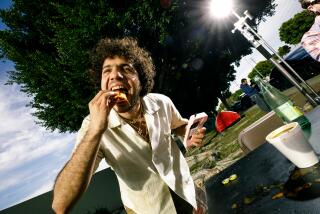Barbecue done in rare form
- Share via
Blackwood Station, N.C. — THE moon was high over the loblolly pines when Keith Allen arrived for work at 2 a.m. He built a fire of hickory logs, and a plume of rich blue smoke creased the black night sky.
When the fire had produced glowing red coals, Allen shoveled them into a pit below two dozen hog shoulders on a metal rack. For the next nine hours, he shoveled more coals, stoked the fire, and turned the shoulders as they cooked a ruddy, smoky brown.
Long after first light, he was still at it. With a cleaver in one hand and a knife in the other, he chopped the pork with a rhythmic whump, whump, whump. Then he plunged two gloved hands into the steaming meat to mix in a homemade sauce of vinegar, salt and red pepper.
And that, for purists, is the long, hard, wearying way of making genuine pit-cooked Eastern North Carolina chopped barbecue.
Not many people do it this way anymore. Most of the state’s barbecue restaurants have switched to gas or electric cooking, which is cheaper, faster and cleaner. Most now chop North Carolina’s signature meal with electric grinders and season it with bottled sauce.
Allen, a tall, silver-haired, second-generation barbecue cook, insists that barbecue that isn’t cooked in a pit over hickory coals and chopped and flavored by hand isn’t really Carolina barbecue. He devotes most of his waking hours to that ideal.
Five days a week, Allen works from 2 a.m. to well past dark, preparing every bite of barbecue served at Allen & Son, a small roadside joint on a winding highway north of Chapel Hill. When Allen takes a day off or goes on vacation, the restaurant closes. He won’t let anyone else make his barbecue. He never sits down for a meal of barbecue -- not even his own, preferring to keep his palate pure for taste-testing.
“What you’re chasing is that flavor,” he said, pronouncing it “flay-vuh” in his silky Tar Heel accent. “If you don’t do it right, you won’t get it.”
ONLY 20 to 30 barbecue restaurants among hundreds in the state still cook with wood, says Bob Garner, author of two books on Carolina barbecue. “But nobody does it to the degree Keith does -- he’s one of a kind,” Garner said.
Allen’s painstaking methods -- cutting his own hickory, manning the fire for hours, chopping his own meat and making his own sauce -- have their roots in a time-honored process. Pigs have been roasted over wood coals in North Carolina since the 17th century.
The process evolved generations ago into the hickory-smoked, seasoned and chopped pork dish known as North Carolina barbecue. (Sauce in the eastern part of the state is vinegar-based; in the west, it’s tomato-based.)
But purists say the delicacy is being compromised by modern shortcuts. That’s why holdouts such as Allen are so significant, Garner said.
“He pursues it with a single-minded devotion,” Garner said. “That’s his niche, and he’d be a fool to change now.”
The best Carolina barbecue consists of lean chunks of succulent pork, with no fat, gristle or “crackling,” i.e., cooked skin. It has a smoky, tangy and slightly acidic taste. The pork is served on buns or with cole slaw and hush puppies, then washed down with sweet iced tea.
“Barbecue” is a noun here, not a verb. Some Tar Heels spell it “barbeque,” or just “que.” It’s a staple at church dinners, business conferences, private parties and even some wedding receptions.
North Carolina, which calls itself a “vale of humility between two mountains of conceit” (Virginia and South Carolina), is proud of barbecue’s origins among the lower classes. According to Garner, the first to cook it were slaves and poor farmers, as hogs were cheaper to raise than cattle.
In recent years, barbecue restaurants have switched from wood because gas and electricity save time, money and effort, Garner said. Wood also produces smoke and soot.
Garner says he’s sampled some excellent Carolina barbecue cooked with gas or electricity, but it doesn’t have the distinctive hickory-smoked flavor.
Allen tastes every batch of barbecue that comes off his chopping block. He seeks that biting, smoky flavor he says only a properly maintained hickory fire can impart over many hours of cooking.
“I think about barbecue like some people think about wine,” he said. “The good stuff? You know it when you taste it.”
Allen says the unique flavor comes from pork juices dripping onto hot hickory coals during the first five hours he cooks the shoulders meat side down. During the four hours the pork cooks skin side down, he says, the skin “acts like a frying pan and catches the juices and seals them in.”
BARBECUE lovers from almost every state have eaten at Allen’s restaurant since it opened 37 years ago. Some customers have flown in private jets from New York and California just to eat there, Allen says, and food celebrities Martha Stewart and Rachael Ray have featured his barbecue.
If you call the restaurant and request mail-order barbecue, Allen will ship it frozen. But he doesn’t have a website and doesn’t advertise or take reservations. He doesn’t own a cellphone.
Some customers have been eating here for more than 30 years. Kenny Snyder, chomping on a barbecue sandwich, said he’s in his 25th year. He and several friends have sampled a dozen barbecue joints in the area over the years, he said, and Allen & Son has been the hands-down winner every time.
“He cooks it the old way -- the right way,” Snyder said. “It’s coarsely chopped, not that fine stuff you get in other places. And it’s clean, with none of that junk in it.”
At $5.35 for a sandwich (with one side order) and $8.95 for a meal, Allen’s barbecue is pricier than most. But he says the price reflects the costs -- in effort and ingredients -- he puts into it.
Allen, 55, was born and raised on a one-horse farm just a few miles down the highway, the son of a barbecue man, the grandson of an illiterate farmer. He has never heard of the slow food movement, the trendy style of patient cooking with natural ingredients, but he embodies its principles.
“I’m not slow,” Allen said. “I’m backward. You have to be pretty stupid to make barbecue this way. It’s hot and miserable in the summer and freezing in the winter. It’s greasy and dirty all the time, and you’ve got ashes and soot all over you.”
Most evenings, Allen hacks at felled hickory trees with an ax and a maul. He gets the hickories from developers and landscapers, or finds them through his part-time landscaping service.
Most mornings, in between tending the barbecue pit, Allen makes 16 desserts, including pecan pie, peach cobbler and cream cheese pound cake. “When I’m not telling lies, I’m making pies,” he said.
He cooks the restaurant’s Brunswick stew, a thick concoction of meats and vegetables. He also makes the cole slaw and French fries -- from fresh potatoes, deep-fried, with the skins on.
On Saturdays, Allen cooks the restaurant’s Southern breakfasts (eggs, gravy, biscuits, sausage, country ham). On Sundays, when the restaurant is closed, he cooks breakfast over a wood stove at home for his wife and 17-year-old daughter. He chops the wood for that, too -- as well as the wood that heats their home.
Allen works the pits in back, while his wife Tammy runs the dining room. Tammy, 43, has worked at the restaurant since she was 15. She remembers being called in from the tobacco fields by her grandmother, who told Tammy she’d just heard that a waitress job had opened up at Allen’s restaurant.
Tammy got the job, and eventually married the owner. “Keith said he’d teach me everything he knew, and he just about did,” she said. But he won’t tell her the secret ingredients of his father’s barbecue sauce.
ALLEN’S father, the late James Allen, opened the original Allen & Son a few miles south of the current location. He bought it in the early 1960s from a Klansman who had a “whites only” sign in the dining room, his son said, and began serving all races.
Allen bought his own restaurant in 1970, at age 19, from a barbecue man named Meaty Turner while on lunch break from his butcher job at the local A&P; market. He says he paid $3,000 down and $3,000 later. For a while, he was the sole employee.
“I didn’t worry about going broke,” he said. “I was already broke.”
Today, the restaurant has a dozen employees, with a 19-table dining room inside a cinderblock building next to railroad tracks. The place is decorated with a deer head and a stuffed duck. It features checkered tablecloths and signs that read, “We Have Sweet Potato Pie Today!” and “Banana Pudding On Fridays.” The clientele is a mix of blue-collar workers, businessmen, students and more than a few men in overalls who do not remove their ball caps to eat.
Allen doesn’t want the place to get any bigger, preferring to stay small so that he can personally prepare every bite of food. He says he still cooks the way his grandmother taught him.
“That’s the way I was brought up: Do it right or get out of the kitchen,” he said.
On this particular day, Allen had just finished chopping and seasoning a couple hundred pounds of barbecue, and the hickory coals were hissing and dying. He wiped his greasy hands and stepped outside to chop a load of hickory for the next morning, when he would once again fire the pit in the dead of night, chasing the flavor another day.
*
More to Read
Sign up for The Wild
We’ll help you find the best places to hike, bike and run, as well as the perfect silent spots for meditation and yoga.
You may occasionally receive promotional content from the Los Angeles Times.







